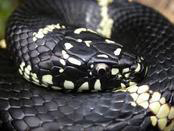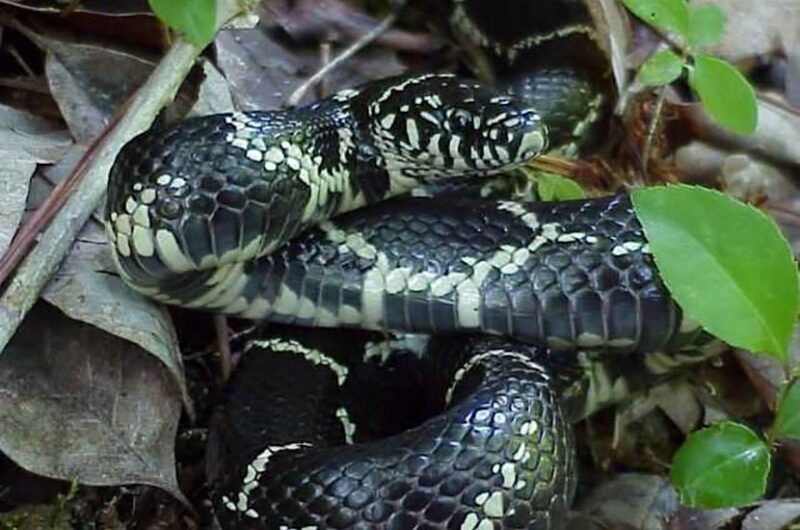Erica Mede, CVT
Description
 Kings are a hardy species and generally live 15-20 years. These are one of the most available snakes that are not in the boa or python family. Kingsnakes are both diurnal and terrestrial sporting the classic round pupils that most people associate with “safe” snakes. When startled, these snakes will often mimic rattling by vibrating their tail quickly.
Kings are a hardy species and generally live 15-20 years. These are one of the most available snakes that are not in the boa or python family. Kingsnakes are both diurnal and terrestrial sporting the classic round pupils that most people associate with “safe” snakes. When startled, these snakes will often mimic rattling by vibrating their tail quickly.
Natural History
These diurnal snakes are found as south as Florida, as north as New Jersey and as west as Tennessee. Kingsnakes frequent cultivated areas such as farms and live on the edges of forests, and prairies in their natural habitat. Throughout their range, this species is known to hibernate but this practice is not necessary in captivity.
Enclosure
Adults are easily kept in a 20-30 gallon glass aquarium with a screen lid. Some people have even utilized modified sweater boxes for keeping these snakes especially hatchlings and wild caught specimens which can be quite flighty. Hatchlings can be kept in 10 gallon aquariums.
Substrate
Substrate should be easy to clean. Newspaper, reptile carpet, and paper towel are favorites for hatchlings and new individuals to help monitor fecal output. Most established individuals can be maintained happily on the above or aspen bedding as long as it is agitated frequently and changed every 7-14 days. Never used pine or cedar shavings as the aromatic oils can cause irritation and respiratory issues in your snake. Enrichment can be provided by placing hay, straw, or even dried leaves in the cage for the snake to explore and navigate through.
 Kings require an ambient temperature of 80-85°F which is easily provided with under tank heaters, heat tape, heat cable (on the outside of the cage not the inside). The temperatures can be controlled easily with a thermostat and monitored with the use of three thermometers. One thermometer placed on the warm end an inch above the substrate, one placed at the level of the basking site, and another placed an inch above the substrate on the cooler end. A basking site should be 85-88°F. At night, the temperature can drop as low as 75°F.
Kings require an ambient temperature of 80-85°F which is easily provided with under tank heaters, heat tape, heat cable (on the outside of the cage not the inside). The temperatures can be controlled easily with a thermostat and monitored with the use of three thermometers. One thermometer placed on the warm end an inch above the substrate, one placed at the level of the basking site, and another placed an inch above the substrate on the cooler end. A basking site should be 85-88°F. At night, the temperature can drop as low as 75°F.
Humidity should be moderate, 35-60%, with the higher end utilized during shedding. Humidity can be monitored with a hygrometer and increased with the use of a large water bowl, fogger, mister, or daily spraying.
Accessories
Branches for climbing should be offered as this species enjoys climbing on low level branches. Natural and fake foliage can be placed in the cage to increase hiding locations. Hide boxes in the form of half logs, PVC pipes, and half flower pots can be utilized. Rocks can be added especially for basking areas if they are placed over a heat source and under the basking light to warm the rock.
Reproduction
Mating season for Kingsnakes begins in June typically. Successful mating will result in the female laying eggs two months after. Kingsnakes lay 8-20 eggs with an average of 10-12 being laid. Hatchlings are tiny, generally 8 inches or so long.
Feeding
In the wild, these snakes feed primarily on rodents such as mice, voles, and moles. In captivity, these snakes are fed primarily mice. It is recommended that only pre-killed prey be offered as live prey has the potential of severely injuring or killing captive snakes, especially those unaccustomed to live prey. Chicago Exotics recommends feeding properly thawed frozen mice. Hatchlings can be fed every 5-7 days. Juveniles should be offered food every 7-10 days and adults fed every 10-14 days.
If you have any questions, please feel free to call us at (502) 241-4117.

